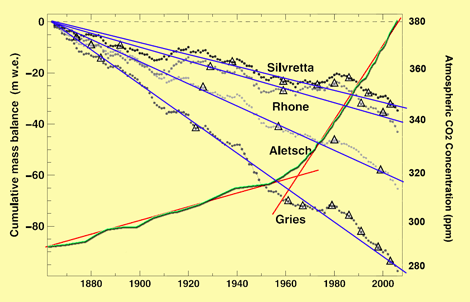Reference
Huss, M., Bauder, A., Funk, M. and Hock, R. 2008. Determination of the seasonal mass balance of four Alpine glaciers since 1865. Journal of Geophysical Research 113: 10.1029/2007JF000803.
What was done
The authors computed the seasonal mass balances of four glaciers in the Swiss Alps (Grosser Aletschgletscher, Rhonegletscher, Griesgletscher and Silvrettagletscher) for the 142-year period 1865-2006, based on a surface melt model coupled with a distributed accumulation model, where temperature and precipitation are the required input variables and the model is calibrated using ice volume changes, in situ mass balance measurements and discharge data.
What was learned
Based on their results, which we have reproduced in the figure below, Huss et al. report that (1) "the cumulative mass balance curves show similar behavior during the entire study period," (2) the mass balances in the 1940s were more negative than those of 1998-2006, and (3) "the most negative mass balance year since the end of the Little Ice Age was not the year 2003 with its exceptional European summer heat wave, but 1947."

Time series of the cumulative mass balances of the four Swiss Alps glaciers. Adapted from Huss et al. (2008).
What it means
In the above figure, we have added the contemporaneous history of the atmosphere's CO2 concentration, and we have inserted "eye-balled" mean trend lines of the glaciers' mass balances. Computing the mean rate-of-rise of the air's CO2 content from the start of the record to about 1950, and from about 1970 to 2006, we see that between approximately 1950 and 1970, the rate-of-rise of the air's CO2 content increased by more than five-fold! However, as the Swiss, American and Swedish researchers note, there were no related changes in the long-term mass balance trends of the glaciers. These observations clearly indicate that the wasting away of the four glaciers has not been influenced in any way by the huge increase in the rate-of-rise of the air's CO2 content that occurred between 1950 and 1970, and that it has likewise not been substantially altered by the "unprecedented" warming of the late 20th century.




